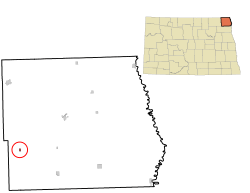Mountain, North Dakota facts for kids
Quick facts for kids
Mountain, North Dakota
|
|
|---|---|

Community Center, originally the school, in Mountain
|
|

Location of Mountain, North Dakota
|
|
| Country | United States |
| State | North Dakota |
| County | Pembina |
| Founded | 1884 |
| Area | |
| • Total | 0.12 sq mi (0.32 km2) |
| • Land | 0.12 sq mi (0.32 km2) |
| • Water | 0.00 sq mi (0.00 km2) |
| Elevation | 1,066 ft (325 m) |
| Population
(2020)
|
|
| • Total | 80 |
| • Estimate
(2022)
|
70 |
| • Density | 655.74/sq mi (252.26/km2) |
| Time zone | UTC-6 (Central (CST)) |
| • Summer (DST) | UTC-5 (CDT) |
| ZIP code |
58262
|
| Area code(s) | 701 |
| FIPS code | 38-54740 |
| GNIS feature ID | 1036172 |
Mountain is a small city in Pembina County, North Dakota, United States. It was founded in 1884. In 2020, about 80 people lived there.
Many people from Iceland moved to Mountain starting in 1879. In 2007, Geir Haarde, who used to be the prime minister of Iceland, visited Mountain. City leaders told him they wanted to raise money for a new community center. The government of Iceland later gave $75,000 to help build it. The new community center was finished in 2016.
Contents
History of Mountain
In the spring of 1878, a small group of Icelandic people came from Canada to explore the area that is now North Dakota. Pastor Pall Thorlaksson is known as the person who helped start the Icelandic settlement around Mountain. This area was first called VIK, which means "cove."
Mountain was officially planned out in 1884. The city got its name because it is located on a higher piece of land. A post office has been open in Mountain since 1881. The Vikur Lutheran Church at Mountain was built in 1884.
Geography of Mountain
Mountain is a small city. According to the United States Census Bureau, the city covers about 0.32 square kilometers (0.12 square miles) of land. There is no water area within the city limits.
Population Changes in Mountain
| Historical population | |||
|---|---|---|---|
| Census | Pop. | %± | |
| 1940 | 205 | — | |
| 1950 | 219 | 6.8% | |
| 1960 | 218 | −0.5% | |
| 1970 | 146 | −33.0% | |
| 1980 | 156 | 6.8% | |
| 1990 | 134 | −14.1% | |
| 2000 | 133 | −0.7% | |
| 2010 | 92 | −30.8% | |
| 2020 | 80 | −13.0% | |
| 2022 (est.) | 70 | −23.9% | |
| U.S. Decennial Census 2020 Census |
|||
Population in 2010
In 2010, the census showed that 92 people lived in Mountain. There were 30 households and 14 families. The city had about 657 people per square mile. Most of the people living in Mountain were White (97.8%).
Out of the 30 households, a small number (13.3%) had children under 18. About 30% were married couples living together. Many households (46.7%) were made up of single individuals. About 13.3% of people lived alone and were 65 years or older. The average household had 1.73 people.
The average age of people in Mountain was 65.5 years old. About 6.5% of residents were under 18. More than half (51.1%) were 65 years or older. There were slightly more females (55.4%) than males (44.6%) in the city.
Notable People from Mountain
- Einar Jonasson (1887-1935) was a politician from Manitoba, Canada. He was born near Mountain. His family moved to Canada in 1888 when he was very young.
See also
 In Spanish: Mountain (Dakota del Norte) para niños
In Spanish: Mountain (Dakota del Norte) para niños

